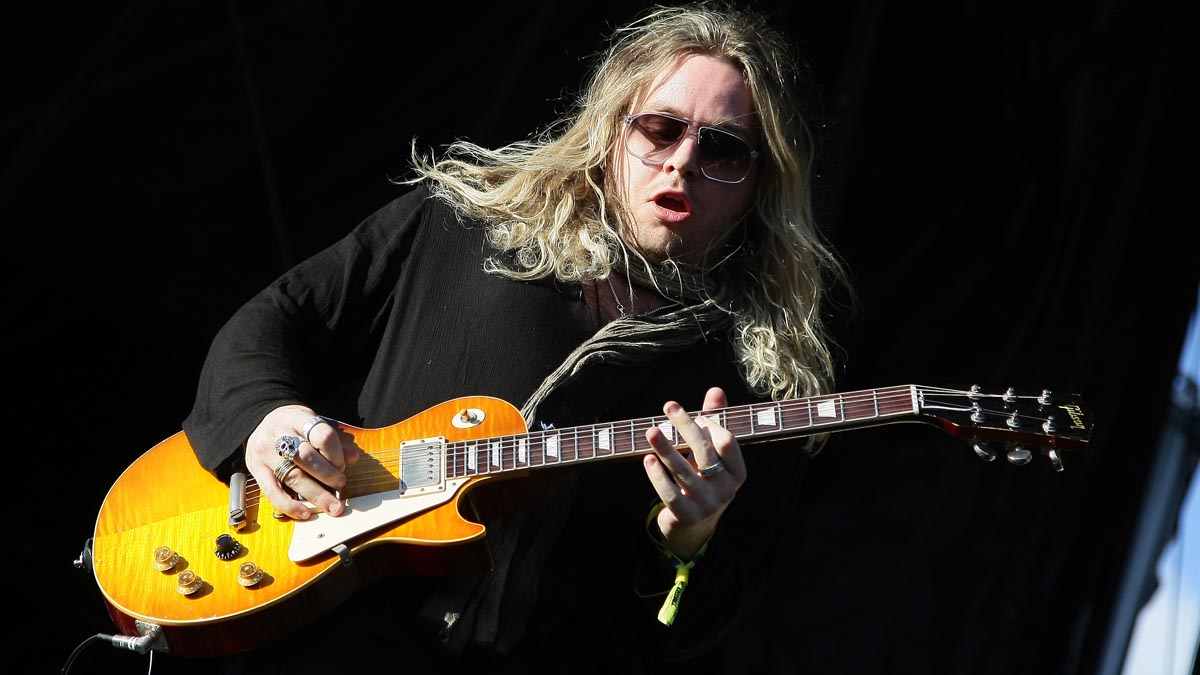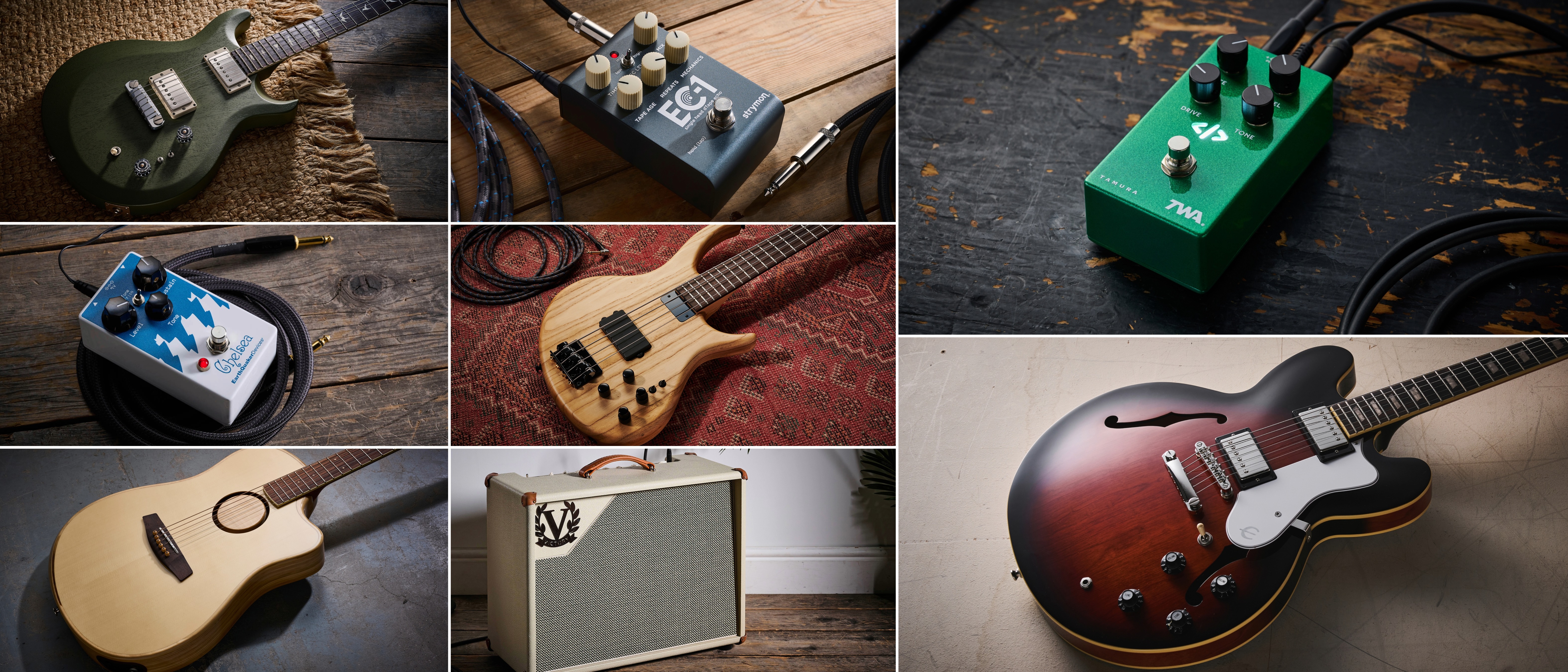The Struts' Adam Slack: “I’ve always listened to old records, where you can hear the skin touching the strings. I found it cooler the sloppier it is“
The guitarist from Britain's fastest-rising rock band talks open tunings, Les Pauls and how Phil Collen stole his solo

In 2020, a lot of musicians have had a lot of time on their hands, but for The Struts, 10 days was all it took to cut one of the best rock records of the year.
“It was essentially recorded live,” says guitarist Adam Slack of the band’s third album Strange Days, for which they decamped to producer John Levine’s home studio. And as Slack explains, it was a very different experience to making their 2018 breakthrough record Young & Dangerous.
“Usually, in the past, I’ve done like 20 guitar tracks, harmonies galore and all that,” he says. “But this time there’s one guitar track on every song, all one live take. I did some overdubs but I didn’t go crazy. John felt we should try and make it sound as much as you can like a live band.
“We didn’t even double-track. John added a tiny delay panned on the other side from the main guitar. He said that’s cooler because it’s what they would have done in the 70s.” Recording in a pandemic meant Adam didn’t have his full live rig available.
“I did use a Kemper on some of the overdubs but the main amp for the whole thing was a Divided by 13 BTR 23. A lot of it is actually just straight into the amp because I’d put a pedal on and be like ‘I kind of liked it when it was just its own,’ just turning up the gain up a little bit and then EQing it myself for each song.
“I had my amp in the little foyer room into the studio covered in blankets because it was so loud. So I just had the head next to me and the cab was in the other room so I could just kind of tweak as I went along with my board.”
The album’s live vibe means that all the imperfections are preserved on the final recording, and as Adam admits: “I listen to it now and there’s so many things I wish I could have done that better. It’s like, ‘Oh, why didn’t I put more vibrato on that note?’ I’ll just have to get over it.”
All the latest guitar news, interviews, lessons, reviews, deals and more, direct to your inbox!
Of course Phil Collen had to play the solo – I’m not going to go back and be like, ‘Excuse me, I don’t like this
Recording in a pandemic also meant the superstar guests recorded their parts remotely, except Robbie Williams, who came onto his porch to allow the band to record his vocals. For Another Hit of Showmanship, The Strokes guitarist Albert Hammond Jr. sent in his parts to take Adam’s Britpop riff to the next level.
On I Hate How Much I Want You, Def Leppard’s Phil Collen added lead guitar. “I was p*ssed off he took my solo!” Adam laughs. “Of course he had to play the solo – I’m not going to go back and be like, ‘Excuse me, I don’t like this.’ And I actually had someone call me up and say ‘I love your solo on I Hate How Much I Want You!’”
Wild Child features a heavy, Zeppelin-esque riff, and the band new immediately who they wanted to play guitar on it.
“Before we went into the studio,’ Adam recalls, “I started banking riffs. I was listening to Arctic Monkeys, stuff like R U Mine? I was like, ‘What if I tried writing something like that?’ I thought the rest of the band were all going to laugh at me because we were never going to play something that heavy.
“That’s why we asked Tom Morello to play on it. It felt so heavy and it had a Rage kind of vibe, so he had to be on it.” However, Adam isn’t overshadowed by all these big names. His own lead style is extremely melodic, and he offers his thoughts on how to develop great lead lines.
“Don’t just pentatonic scale it the whole time. It’s about trying to hit those chordal tones as you go through the music, and being more theory-driven, I guess. I always try and sing it first, and turn whatever I sang into the guitar solo.
“I always try and write more melodic licks. I love Brian May and the session guitarist Tim Pierce, who plays on everything. I’ve just studied what he plays, how he moves over the changes and how melodic he is and that’s what I try to do.”
Melody is king, but the album still has some wild guitar wig-outs. “I like my noodle-fest at the end of Cool,” he says. “It literally feels like the train’s about to derail at any point. I used to listen to those old Stones songs, Can’t You Hear Me Knocking or Sympathy For The Devil’’. It just feels like, ‘where’s it going?!’ I just love that uncertainty of it, so I was inspired by that.”
I’ve always listened to old records, where you can almost hear the skin touching the strings
There’s also a Keith Richards-style looseness to his playing, an influence that shows up most obviously when he uses Keef’s favourite Open G tuning on the title track.
“I’ve always listened to old records, where you can almost hear the skin touching the strings. The sloppier it is I always found it cooler. It’s not about playing bad per se, but don’t try and play it so perfectly... which is easy for me!”
“Overall, it’s the most guitar-y album we’ve done,” reckons Adam. For all the riffing, though, there were just two guitars used. My main Les Paul is the Mike McCready Custom Shop one that I’ve played pretty much every gig since I bought it. I just love it. I didn’t even know who Mike McCready was when I got it!
“I got this custom-made Strat in February made by a guy called Bruce Nelson in LA. I found him through Graham [Whitford] from Tyler Bryant and the Shakedown. Graham’s dad is Brad Whitford from Aerosmith, and Bruce makes Joe Perry’s guitars. It’s a Strat with a humbucker in the bridge, big headstock, and a custom neck.”
To compensate for the lack of overdubs, Adam created a massive sound, but his pedalboard is surprisingly compact. “It’s pretty simple really, just overdrive, a fuzz here and there, and delay on a solo. The reverb’s on all the time, and the Boss on every solo and most rhythm tracks.”
A lot of fuzz pedals don’t work well with humbucking guitars or wireless systems, so I’ve just really struggled with them. The XTS Harlequin octave fuzz just sounds wicked with everything that I use
The amp is boosted with a SoloDallas Storm, which adds compression based on the wireless system Angus Young used to record Back In Black. Reverb comes from a Strymon Flint’s 70s setting, delay from an MXR Carbon Copy, and for solos he often kicks in a Rimrock Mythical Overdrive.
His Boss CE-2W chorus, in CE-1 vibrato mode, is on every solo and most rhythm tracks, subtly thickening the tone. But his current favourite pedal is the XTS Harlequin octave fuzz: “A lot of fuzz pedals don’t work well with humbucking guitars or wireless systems, so I’ve just really struggled with them. This one just sounds wicked with everything that I use, so that was a real secret weapon.”
Tone hounds have praised Adam’s live sound, which comes from a blend of three amps. “It’s a Vox AC30 on top boost, a SoloDallas Black Flag, and a one-speaker, one-knob Supro. Everything goes through all of them. It covers every base, because you’ve got the Marshall kind of power from the Black Flag, the chimey Vox, and then this snotty little mid-rangey Supro.”
I’m picking up the guitar every day, even if it’s just working on my alternate picking technique. I’ve just got to keep playing, especially when we’re not gigging...
Whatever amp he’s using, Adam has a formula for an effective live tone. “I like pumping up the mids, taking down the treble, and getting the amp volume to where the clean starts to break up naturally. Then I’d whack an overdrive like my SoloDallas pedal on.”
Despite the pandemic, Adam remains motivated. “I’m picking up the guitar every day, even if it’s just working on my alternate picking technique. I’ve just got to keep playing, especially when we’re not gigging...”
It’s this dedication to improving that has kept The Struts moving upwards, and Adam is optimistic about their upcoming gigs. “We did some drive-in shows in August in Philadelphia and in Pittsburgh. I thought they’d have to stay in their cars but they managed to sit on the cars and enjoy the show. “That,” he smiles, “was cool.”
- The Struts' new album, Strange Days, is out now via Interscope.
